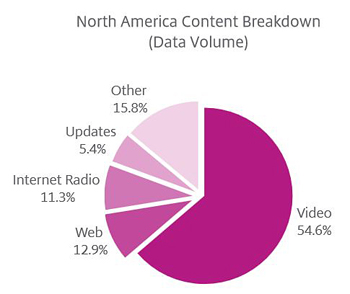Calculating the Impact of LTE Networks
SPRINGFIELD, VA. ― It's probably no surprise that Americans are increasingly watching video on their cell phones and tablets. Just how much mobile video consumption happens is starting to become interesting, and it is the subject of a study by Citrix.

Citrix, probably best known for its collaboration software that allows people to have joint computer conferences, also analyzes trends is data usage. In a report released a couple days ago, the company said that mobile video data is now more than half of all cellular data.
In fact, North America leads all regions with video viewing consuming 54.6 percent of all cellular data. Next highest is Europe at 52 percent, and the lower number there might be one reason why European telecom companies have started lobbying the European Commission to free up spectrum at UHF frequencies now used by broadcasters. Seeing that North American cellular companies have gotten that spectrum and implemented LTE networks, the Europeans don't want to fall too far behind.
Drilling down into the data, social networking (such as Facebook activity) generates only 10.3 percent of all cellular data. However, of that 10.3 percent, 87 percent is attributed to video and images. In other words, approximately nine percent of all cellular data is the result of video and image activity on Facebook and other social networking sites.
MAJOR PORTALS
Two major portals for mobile video are YouTube and Netflix, which show interesting differences in their consumption patterns. Of the two (at least in 2014), YouTube is the 800-pound gorilla, responsible more than 71 percent of all mobile video data.
When it comes to what people are watching on these two services, YouTube and Netflix complement each other with their usage patterns. According to Citrix, 81 percent of all mobile YouTube viewing is for less than five minutes, while more than 76 percent of all mobile Netflix viewing is for more than five minutes.

Another interesting find in the statistics is that Apple iOS devices proportionately consume considerably more video than Android devices. Android users average 27.5 percent video consumption daily, while iOS devices claim 38 percent.
The professional video industry's #1 source for news, trends and product and tech information. Sign up below.
Speed has something to do with data usage, as Citrix found that 4G LTE devices are 1.5 times more likely to view video than 3G devices. This completely correlates with my personal experience, since I am much more likely to call up a video on my 4G phone when I am in a 4G coverage area. When I get good 4G coverage, high-resolution videos load in a couple of seconds and do not buffer, while 3G video watching is a frustration of video buffering and loss of resolution.
The good news for us in North America is that Citrix found we have the lowest buffering and server response times in the world, almost certainly the result of fast LTE wireless networks that have rolled out quickly in the U.S. An example given in the Citrix study is that videos stall for about 7.5 seconds out of one minute in North America, while that number is 38.4 seconds in the Asia-Pacific region.
PERVASIVE ADVERTISING
Although advertising seems pervasive on the Internet, and we see ads on our cell phones all the time, Citrix found that advertising consumed only about two percent of the total data. If you pay $50 per month for your wireless account, this means that $1 goes to pay for the ads you don't want to see in the first place. That may not be much, but it is an annoyance for those of us who are naturally thrifty.

Broadcasters may not like the upheaval in the UHF spectrum that has caused multiple channel re-alignments. However, consumers are voting with their money to pay for upgraded data services that telecom companies have quickly built out in the former broadcast spectrum.
Just how fast is LTE cellular service? I regularly test my LTE connection in various locations, and it certainly varies depending on where I am. However, at home on my dining room table, I routinely get download speeds of more than 20 Mbps and upload speeds of more than 10 Mbps. There is no question that you can deliver quality video with such a service, as long as you don't mind watching it on a tiny screen equipped with a miniscule loudspeaker.
Bob Kovacs is the former Technology Editor for TV Tech and editor of Government Video. He is a long-time video engineer and writer, who now works as a video producer for a government agency. In 2020, Kovacs won several awards as the editor and co-producer of the short film "Rendezvous."

